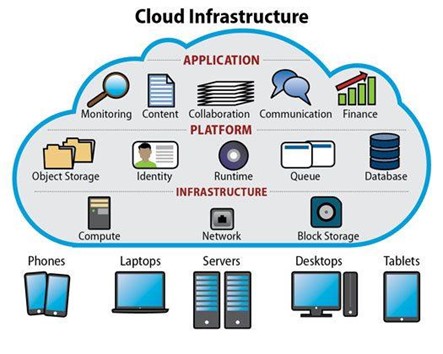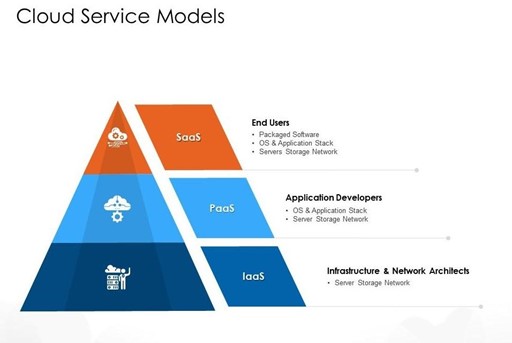2024 Guide to Cloud Infrastructure Management
As the digital business world advances and the cloud becomes an increasingly central part of the way we operate and communicate, effective cloud infrastructure management has become essential to succeed. It’s what ensures the many moving and complex parts of your infrastructure are overseen, optimized, and secure so that your cloud operations can run smoothly.
But what does cloud infrastructure actually entail? What are the best practices for doing it right? Can managed IT service providers providers help with infrastructure management, and if so, how?
These are the critical questions we’ll answer in this guide. When you’re done reading, you’ll understand the full scope of cloud infrastructure management and how to ensure your organization has a strategy in place to achieve maximum value from your cloud investments.
Quick Takeaways:
- Cloud infrastructure is the comprehensive process of managing, optimizing, and securing assets that make up an enterprise cloud environment.
- It’s different from cloud computing, which involves service delivery, and cloud architecture, which involves structurally designing a cloud infrastructure.
- Key cloud management best practices include embracing automation, making security a strategic priority, and emphasizing scalability and flexibility at all times.
- Hiring an expert cloud management solutions provider allows you to offload the heavy lift of cloud infrastructure management and focus on strategic goals.
What is Cloud Infrastructure Management?
Cloud infrastructure management is the end-to-end process of overseeing and administering hardware and software components that make up a cloud environment. This includes tasks such as configuration, deployment, maintenance, optimization, and cloud enterprise workload management.
It’s a comprehensive approach that ensures an enterprise’s cloud environment is always performant and that all resources are effectively utilized, secure, and aligned with broader business objectives.
In today’s digital era, cloud infrastructure management is a cornerstone of larger operational efficiency and innovation. It also enables organizations to swiftly adapt to new market demands, scale resources as needed, and maintain robust cloud security protocols that safeguard sensitive data.
Cloud Infrastructure vs. Cloud Computing vs. Cloud Architecture
Understanding the criticality of cloud infrastructure management requires also understanding how it is related—and also distinct—from other key aspects of cloud operations. More specifically, it’s important to note the relationship between these three terms: cloud infrastructure, cloud computing, and cloud architecture.
Cloud Infrastructure: The Foundation
Cloud infrastructure refers to all essential physical and virtual resources that make up an environment where cloud services operate. This includes hardware (such as servers and storage devices) and software (like virtual machines, applications, and cloud management platforms) required to run cloud services and keep the environment secure.

Cloud infrastructure forms the backbone of any cloud environment and focuses on setup, maintenance, and continual optimization.
Cloud Computing: The Service Delivery
Cloud computing describes the delivery of various services over the internet, including servers, storage, databases, networking, software, and analytics. It represents the actual usage and delivery models of cloud technology, where cloud infrastructure serves as the platform upon which these services are built.
There are three primary cloud computing service models:
- Infrastructure as a Service (IaaS): Offers fundamental computing resources like virtual machines, storage, and networks.
- Platform as a Service (PaaS): Provides a platform allowing customers to develop, run, and manage applications without the complexity of building and maintaining infrastructure.
- Software as a Service (SaaS): Delivers software applications over the internet, on a subscription basis, where cloud providers manage the infrastructure and platforms that run them.

In addition to these models, cloud computing can be deployed in different environments:
- Public Cloud: Services are delivered over the public internet and shared by several organizations.
- Private Cloud: Infrastructure is exclusively used by a single organization.
- Hybrid Cloud: Combines both public and private clouds, allowing data and applications to be shared between them.
Cloud Architecture: The Blueprint
Cloud architecture, distinct from both cloud infrastructure and cloud computing, refers to the conceptual and structural design of the cloud environment. It involves intentionally arranging cloud components and their interrelationships to form a cohesive operating environment.
Cloud architecture is the blueprint that guides the deployment and management of cloud infrastructure components and computing services, defining how they work together to meet specific business needs.
Cloud Infrastructure Management Best Practices
Effective cloud infrastructure management requires an ongoing understanding of evolving industry best practices and trends. As new technologies emerge and cloud capabilities advance, it’s essential to stay on the pulse of current trends and requirements for cloud success. In 2024, these best practices include:
Embrace Automation and Orchestration
Automating repetitive tasks related to cloud infrastructure management, such as provisioning, scaling, and monitoring, can significantly enhance efficiency and reduce the risk of human error. Orchestration tools help in managing complex workflows and resources across various cloud environments, allowing for more streamlined and effective cloud operations.
Implement Robust Security Measures
As cloud environments become increasingly complex, so do cloud security challenges. Implementing a comprehensive cloud security strategy is vital. It should include regular risk assessments, robust data encryption and privacy measures, responsive disaster recovery, and proactive threat identification and mitigation tactics.
In short, cloud security must evolve into a top strategic priority in order for organizations to continue to embrace new technologies and innovate with confidence—and without the threat of compromisation.
Optimize for Cost and Performance
Regularly reviewing and optimizing cloud resources for cost and performance is a must. Utilize cost management tools to monitor cloud spending and identify areas for cost reduction that won’t require compromising on performance.
Employing strategies like rightsizing resources, choosing appropriate storage solutions, and optimizing cloud services usage can lead to significant cost savings.
Prioritize Scalability and Flexibility
Designing cloud infrastructure with scalability and flexibility in mind allows businesses to quickly adapt to changing needs. Leveraging scalable solutions such as containerization and microservices can provide the agility needed to respond to fluctuating demands and new opportunities.
Focus on Disaster Recovery and Business Continuity
Establishing robust disaster recovery and business continuity plans is critical. Cloud infrastructure should include redundant systems and data backup strategies to ensure a quick recovery in the event of data loss or system failure.
Invest in Continuous Training and Skills Development
The rapidly changing cloud landscape necessitates ongoing education and training for IT staff and all employees who utilize the cloud. Investing in skills development ensures that your team is equipped to handle the latest cloud technologies and leverage them for maximum business value.
Leverage Cloud Management Platforms
Cloud management platforms provide a unified view of multi-cloud environments, streamline enterprise workload cloud management tasks, and deliver valuable data-driven insights for optimization. These platforms are extremely effective for managing diverse sets of cloud resources, services, and applications in a centralized and efficient way.
By integrating these best practices into your cloud infrastructure management strategy, enterprises can ensure they’re maximizing the potential of their cloud investments. These approaches enhance operational efficiency and cost-effectiveness, while also positioning businesses to be more agile, secure, and resilient in the face of evolving market demands and technological advancements.
Hiring a Cloud Management Solutions Provider
In the complex and ever-evolving world of cloud infrastructure management, hiring an expert service provider can be the best strategic move for businesses to maximize the efficiency and effectiveness of their cloud operations.
Engaging with a cloud management solutions provider brings a multitude of benefits, ensuring that cloud infrastructure is not just functional but also fully optimized to support business objectives. These benefits include:
Benefits of Cloud Management Tools:
Access to Expertise and Specialized Knowledge
Cloud infrastructure management providers possess specialized knowledge and experience that can be pivotal in navigating the intricacies of cloud environments. Their expertise often spans various industries, offering insights into best practices and emerging trends.
They’re also equipped with teams of experts who are proficient in the latest cloud technologies and methodologies. This expertise is vital for businesses that may not have the internal resources to manage complex cloud environments effectively.
Enhanced Security and Compliance
As cybersecurity threats become more sophisticated, expert service providers deliver advanced security measures that keep your cloud environment protected. These include regular security audits, compliance checks, and proactive threat monitoring.
They also stay abreast of the latest regulatory requirements and ensure that your cloud infrastructure is compliant, reducing the risk of costly penalties and legal issues.
Cost-Efficiency and Resource Optimization
One of the key advantages of hiring a provider is their ability to optimize cloud resource utilization, ensuring you get the most out of your cloud investment without overspending. Outsourcing your cloud infrastructure management can alleviate the burden on internal teams, freeing them to focus on core business activities.
Scalability and Flexibility
Cloud infrastructure management service providers can quickly scale services up or down based on your current business demands, providing flexibility that is difficult to achieve with in-house resources. They also offer tailored solutions that align with specific business objectives, whether it's scaling infrastructure to support growth or integrating new technologies for digital transformation.
Continuous Monitoring and Support
Continuous monitoring of cloud environments ensures that performance issues or security threats are identified and addressed promptly. When you outsource cloud infrastructure management, expert support and guidance are available around the clock, offering peace of mind and the quick resolution of any issues that arise.
Staying Ahead of Technological Advancements
Cloud management providers continually invest in and adopt the latest technologies, ensuring that your cloud infrastructure benefits from cutting-edge advancements. With their forward-looking approach, cloud managed service providers can help future-proof your cloud infrastructure, keeping it aligned with evolving business strategies and market conditions.
In summary: Hiring an expert cloud solutions provider can help you streamline and optimize your cloud infrastructure management strategy, driving greater efficiency, innovation, and growth. By leveraging their expertise and resources, you can ensure your infrastructure is not only robust and secure, but also agile and aligned with your company’s long-term vision for success.
Manage Your Cloud Journey with Protera
Reap the rewards of a well architected, innovation-connected cloud with Protera. Whether it’s your first cloud migration or one of many cloud modernization initiatives you can benefit from Protera’s proactive modern cloud services, which include:
- IT operations
- Infrastructure management
- Application management
- Security and risk management
- Strategy and governance
Protera’s solutions allow clients to offload critical cloud management tasks while embracing innovative native cloud capabilities to achieve and exceed business goals.
Talk to a Protera expert today to learn more